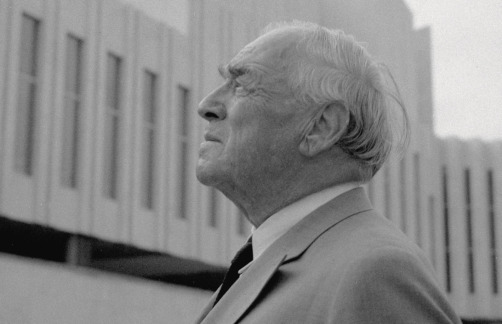Alvar Aalto
The friendship with Göran Schildt
Göran Schildt first met Alvar Aalto during his academic years when Aalto was the president of the film club Projektio and Schildt a member. They became friends much later, however, when Schildt visited Aalto’s office together with his Italian friend Roberto Sambonet in 1952. Göran Schildt describes his fascination with Aalto in the following words:
“From that day I was irretrievably drawn into the magic circle around the cheerful socialite, the ingenious artist and the worldly-wise humanist.”
Aalto gladly showed his drawings to Göran Schildt and they travelled together in Finland, Italy and Egypt. They both had a great interest in Mediterranean culture and engaged in many conversations regarding it. After Aalto’s death in 1976, Göran Schildt wrote a biography about the architect in three volumes.
Alvar Aalto’s life
Alvar Aalto was born on February 3, 1898, in Kuortane and lived there until 1905, when the family moved to Jyväskylä. The family included his father, the district surveyor J. H. Aalto, mother Selma Matilda (b. Hackstedt) and four children. In 1906, Aalto’s mother died and his father married Selma’s sister Flora Hackstedt.
Alvar Aalto matriculated from Jyväskylä Lyceum in 1916 and continued his education at the Helsinki Institute of Technology (later Helsinki University of Technology and now a part of the Aalto University). After graduating as an architect in 1921, Aalto set up his first architectural practise in Jyväskylä and hired architect Aino Marsio (1894-1949) as an assistant. They married in 1924 and had two children.
National and international success
In 1927 the family moved to Turku after Aalto had won the competition for Southwestern Finland Agricultural Cooperative Building in Turku. Turku was an inspiring city, and Aalto moved his agency there. It was during this period he planned the Paimio sanatorium which was completed in 1933. The Paimio Sanatorium was a gesamtkunstwerk, a comprehensive work of art that consisted of designing the building as well as the interior, including lighting, sanitary ware, examination tables, etc. It was with this building that he managed to make a partial international breakthrough, although he later became better known for his furniture.
After the success of the Paimio-project Aalto decided to try his luck in Helsinki and opened an office there in 1933. The architects in the Helsinki area belonged to the old generation and it was not easy for him to find work there. His successful cooperation with the carpenter Otto Korhonen made him more independent of clients in Helsinki, however.
Nature as a source of inspiration
Aalto’s designs were inspired by nature and featured characteristics drawn from it. His most significant buildings include Villa Mairea in Noormarkku, the Finlandia Hall in Helsinki, and the Aalto Centre in Seinäjoki.
Alvar Aalto’s first wife Aino died in 1949. In 1952, he married Elissa Mäkiniemi, and together they bought an experimental house in Muuratsalo where he could try out his ideas, especially regarding the use of different kinds of bricks.
In 1958, Aalto withdrew from public life and focused on writing and drawing. He won several architectural competitions at the end of the 1950s including the Kiruna City Hall, the Aalborg Art Museum, and the theatre in Essen. In the 1960s, he was responsible for the planning of several larger projects, such as the Seinäjoki and Rovaniemi city centres. From 1963 to 1968 Aalto acted as the President of the Academy of Finland.
Aalto died in 1976 and is buried at the Hietaniemi Cemetery.
Read more about Alvar Aalto here.
